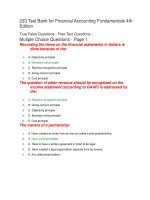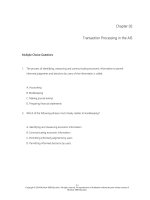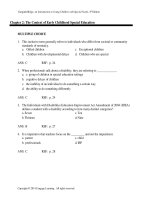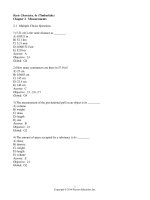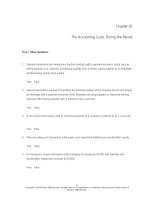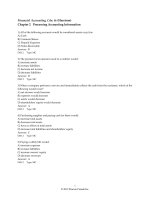Financial accounting fundamentals 4th edition wild test bank
Bạn đang xem bản rút gọn của tài liệu. Xem và tải ngay bản đầy đủ của tài liệu tại đây (632.96 KB, 148 trang )
Chapter 02 – Accounting for Transactions
Chapter 02
Accounting for Transactions
True / False Questions
[Question]
1. Accounting records are also referred to as the books.
Answer: TRUE
Blooms Taxonomy: Remember
AACSB: Analytic
AACSB: Communication
AICPA BB: Critical Thinking
AICPA BB: Industry
AICPA FN: Measurement
AICPA FN: Reporting
Difficulty: 1 Easy
Learning Objective: 02-C1
Topic: Accounting Records
[Question]
2. The first step in the analyzing and recording process is to analyze each transaction and
event from source documents.
Answer: TRUE
Blooms Taxonomy: Remember
AACSB: Analytic
AACSB: Communication
AICPA BB: Critical Thinking
AICPA BB: Industry
AICPA FN: Measurement
AICPA FN: Reporting
Difficulty: 1 Easy
Learning Objective: 02-C1
Topic: Source Documents
Topic: Accounting Records
2-1
© 2013 by McGraw-Hill Education. This is proprietary material solely for authorized instructor use. Not authorized for sale or
distribution in any manner. This document may not be copied, scanned, duplicated, forwarded, distributed, or posted on a website, in
whole or part.
Chapter 02 – Accounting for Transactions
[Question]
3. Preparation of a trial balance is the first step in the analyzing and recording process.
Answer: FALSE
Blooms Taxonomy: Remember
AACSB: Analytic
AACSB: Communication
AICPA BB: Critical Thinking
AICPA BB: Industry
AICPA FN: Measurement
AICPA FN: Reporting
Difficulty: 1 Easy
Learning Objective: 02-C1
Topic: Accounting Records
[Question]
4. Items such as sales slips, invoices, checks, and purchase orders are source documents.
Answer: TRUE
Blooms Taxonomy: Understand
AACSB: Analytic
AACSB: Communication
AICPA BB: Critical Thinking
AICPA BB: Industry
AICPA FN: Measurement
AICPA FN: Reporting
Difficulty: 2 Medium
Learning Objective: 02-C1
Topic: Source Documents
[Question}
5. An account is a record of increases and decreases in a specific asset, liability, equity,
revenue, or expense item.
Answer: TRUE
Blooms Taxonomy: Remember
AACSB: Analytic
AACSB: Communication
AICPA BB: Critical Thinking
AICPA BB: Industry
AICPA FN: Measurement
AICPA FN: Reporting
Difficulty: 1 Easy
Learning Objective: 02-C2
Topic: Account
2-2
© 2013 by McGraw-Hill Education. This is proprietary material solely for authorized instructor use. Not authorized for sale or
distribution in any manner. This document may not be copied, scanned, duplicated, forwarded, distributed, or posted on a website, in
whole or part.
Chapter 02 – Accounting for Transactions
[Question]
6. According to the seller, a customer's promise to pay is called an account payable.
Answer: FALSE
Blooms Taxonomy: Understand
AACSB: Analytic
AACSB: Communication
AICPA BB: Critical Thinking
AICPA BB: Industry
AICPA FN: Measurement
AICPA FN: Reporting
Difficulty: 2 Medium
Learning Objective: 02-C2
Topic: Account Receivable
Topic: Account Payable
Topic: Account
[Question]
7. Dividends are a type of business expense.
Answer: FALSE
Blooms Taxonomy: Remember
AACSB: Analytic
AACSB: Communication
AICPA BB: Critical Thinking
AICPA BB: Industry
AICPA FN: Measurement
AICPA FN: Reporting
Difficulty: 1 Easy
Learning Objective: 02-C2
Topic: Dividends
Topic: Account
[Question]
8. As prepaid expenses are used up, the costs of these assets become expenses.
Answer: TRUE
Blooms Taxonomy: Understand
AACSB: Analytic
AACSB: Communication
AICPA BB: Critical Thinking
AICPA BB: Industry
AICPA FN: Measurement
AICPA FN: Reporting
Difficulty: 2 Medium
Learning Objective: 02-C2
Topic: Prepaid Expenses
Topic: Account
2-3
© 2013 by McGraw-Hill Education. This is proprietary material solely for authorized instructor use. Not authorized for sale or
distribution in any manner. This document may not be copied, scanned, duplicated, forwarded, distributed, or posted on a website, in
whole or part.
Chapter 02 – Accounting for Transactions
[Question]
9. Land and buildings are generally recorded in the same ledger account.
Answer: FALSE
Blooms Taxonomy: Understand
AACSB: Analytic
AACSB: Communication
AICPA BB: Critical Thinking
AICPA BB: Industry
AICPA FN: Measurement
AICPA FN: Reporting
Difficulty: 2 Medium
Learning Objective: 02-C2
Topic: Land
Topic: Building
Topic: Account
[Question]
10. It is not necessary to keep separate accounts for all items of importance for business
decisions.
Answer: FALSE
Blooms Taxonomy: Understand
AACSB: Analytic
AACSB: Communication
AICPA BB: Critical Thinking
AICPA BB: Industry
AICPA FN: Measurement
AICPA FN: Reporting
Difficulty: 2 Medium
Learning Objective: 02-C2
Topic: Account
[Question]
11. Unearned revenues are classified as liabilities.
Answer: TRUE
Blooms Taxonomy: Remember
AACSB: Analytic
AACSB: Communication
AICPA BB: Critical Thinking
AICPA BB: Industry
AICPA FN: Measurement
AICPA FN: Reporting
Difficulty: 1 Easy
Learning Objective: 02-C2
Topic: Unearned Revenue
2-4
© 2013 by McGraw-Hill Education. This is proprietary material solely for authorized instructor use. Not authorized for sale or
distribution in any manner. This document may not be copied, scanned, duplicated, forwarded, distributed, or posted on a website, in
whole or part.
Chapter 02 – Accounting for Transactions
[Question]
12. Cash dividends should be treated as an expense to the business.
Answer: FALSE
Blooms Taxonomy: Remember
AACSB: Analytic
AACSB: Communication
AICPA BB: Critical Thinking
AICPA BB: Industry
AICPA FN: Measurement
AICPA FN: Reporting
Difficulty: 1 Easy
Learning Objective: 02-C2
Topic: Dividends
[Question]
13. When a company provides services for which cash will not be received until some future
date, the company should record unearned revenue for the amount charged to the customer.
Answer: FALSE
Blooms Taxonomy: Apply
AACSB: Analytic
AACSB: Communication
AICPA BB: Critical Thinking
AICPA BB: Industry
AICPA FN: Measurement
AICPA FN: Reporting
Difficulty: 3 Hard
Learning Objective: 02-C2
Topic: Account
Topic: Unearned Revenue
Topic: Revenue Recognition
2-5
© 2013 by McGraw-Hill Education. This is proprietary material solely for authorized instructor use. Not authorized for sale or
distribution in any manner. This document may not be copied, scanned, duplicated, forwarded, distributed, or posted on a website, in
whole or part.
Chapter 02 – Accounting for Transactions
[Question]
14. The chart of accounts is a list of all the accounts used by a company and a corresponding
identification number.
Answer: TRUE
Blooms Taxonomy: Remember
AACSB: Analytic
AACSB: Communication
AICPA BB: Critical Thinking
AICPA BB: Industry
AICPA FN: Measurement
AICPA FN: Reporting
Difficulty: 1 Easy
Learning Objective: 02-C3
Topic: Chart of Accounts
[Question]
15. An account balance is the difference between the debits and credits for an account
including any beginning balance.
Answer: TRUE
Blooms Taxonomy: Remember
AACSB: Analytic
AACSB: Communication
AICPA BB: Critical Thinking
AICPA BB: Industry
AICPA FN: Measurement
AICPA FN: Reporting
Difficulty: 1 Easy
Learning Objective: 02-C4
Topic: Account Balance
[Question]
16. Debit means the right-hand side of any account.
Answer: FALSE
Blooms Taxonomy: Remember
AACSB: Analytic
AACSB: Communication
AICPA BB: Critical Thinking
AICPA BB: Industry
AICPA FN: Measurement
AICPA FN: Reporting
Difficulty: 1 Easy
Learning Objective: 02-C4
Topic: Debit
2-6
© 2013 by McGraw-Hill Education. This is proprietary material solely for authorized instructor use. Not authorized for sale or
distribution in any manner. This document may not be copied, scanned, duplicated, forwarded, distributed, or posted on a website, in
whole or part.
Chapter 02 – Accounting for Transactions
[Question]
17. In a double-entry accounting system, the total amount debited must always equal the-total
amount credited.
Answer: TRUE
Blooms Taxonomy: Remember
AACSB: Analytic
AACSB: Communication
AICPA BB: Critical Thinking
AICPA BB: Industry
AICPA FN: Measurement
AICPA FN: Reporting
Difficulty: 1 Easy
Learning Objective: 02-C4
Topic: Double Entry Accounting System
Topic: Debit
Topic: Credit
[Question]
18. Increases in liability accounts are recorded as debits.
Answer: FALSE
Blooms Taxonomy: Remember
AACSB: Analytic
AACSB: Communication
AICPA BB: Critical Thinking
AICPA BB: Industry
AICPA FN: Measurement
AICPA FN: Reporting
Difficulty: 1 Easy
Learning Objective: 02-C4
Topic: Debit
Topic: Liabilities
2-7
© 2013 by McGraw-Hill Education. This is proprietary material solely for authorized instructor use. Not authorized for sale or
distribution in any manner. This document may not be copied, scanned, duplicated, forwarded, distributed, or posted on a website, in
whole or part.
Chapter 02 – Accounting for Transactions
[Question]
19. Debits increase both asset and expense accounts.
Answer: TRUE
Blooms Taxonomy: Remember
AACSB: Analytic
AACSB: Communication
AICPA BB: Critical Thinking
AICPA BB: Industry
AICPA FN: Measurement
AICPA FN: Reporting
Difficulty: 1 Easy
Learning Objective: 02-C4
Topic: Debit
Topic: Assets
Topic: Expenses
[Question]
20. Double-entry accounting requires that the impact of each transaction be recorded in at
least two accounts.
Answer: TRUE
Blooms Taxonomy: Understand
AACSB: Analytic
AACSB: Communication
AICPA BB: Critical Thinking
AICPA BB: Industry
AICPA FN: Measurement
AICPA FN: Reporting
Difficulty: 2 Medium
Learning Objective: 02-C4
Topic: Double Entry Accounting System
2-8
© 2013 by McGraw-Hill Education. This is proprietary material solely for authorized instructor use. Not authorized for sale or
distribution in any manner. This document may not be copied, scanned, duplicated, forwarded, distributed, or posted on a website, in
whole or part.
Chapter 02 – Accounting for Transactions
[Question]
21. A revenue account normally has a debit balance.
Answer: FALSE
Blooms Taxonomy: Understand
AACSB: Analytic
AACSB: Communication
AICPA BB: Critical Thinking
AICPA BB: Industry
AICPA FN: Measurement
AICPA FN: Reporting
Difficulty: 2 Medium
Learning Objective: 02-C4
Topic: Debit
Topic: Revenue
[Question]
22. Accounts are normally decreased by debits.
Answer: FALSE
Blooms Taxonomy: Understand
AACSB: Analytic
AACSB: Communication
AICPA BB: Critical Thinking
AICPA BB: Industry
AICPA FN: Measurement
AICPA FN: Reporting
Difficulty: 2 Medium
Learning Objective: 02-C4
Topic: Debit
[Question]
23. The dividends account normally has a credit balance since it is an equity account.
Answer: FALSE
Blooms Taxonomy: Understand
AACSB: Analytic
AACSB: Communication
AICPA BB: Critical Thinking
AICPA BB: Industry
AICPA FN: Measurement
AICPA FN: Reporting
Difficulty: 2 Medium
Learning Objective: 02-C4
Topic: Credit
Topic: Dividends
2-9
© 2013 by McGraw-Hill Education. This is proprietary material solely for authorized instructor use. Not authorized for sale or
distribution in any manner. This document may not be copied, scanned, duplicated, forwarded, distributed, or posted on a website, in
whole or part.
Chapter 02 – Accounting for Transactions
[Question]
24. Asset accounts normally have credit balances and expense accounts normally have debit
balances.
Answer: FALSE
Blooms Taxonomy: Remember
AACSB: Analytic
AACSB: Communication
AICPA BB: Critical Thinking
AICPA BB: Industry
AICPA FN: Measurement
AICPA FN: Reporting
Difficulty: 1 Easy
Learning Objective: 02-C4
Topic: Credit
Topic: Debit
Topic: Assets
Topic: Expenses
[Question]
25. Common Stock normally has a debit balance.
Answer: FALSE
Blooms Taxonomy: Remember
AACSB: Analytic
AACSB: Communication
AICPA BB: Critical Thinking
AICPA BB: Industry
AICPA FN: Measurement
AICPA FN: Reporting
Difficulty: 1 Easy
Learning Objective: 02-C4
Topic: Debit
Topic: Common Stock
2-10
© 2013 by McGraw-Hill Education. This is proprietary material solely for authorized instructor use. Not authorized for sale or
distribution in any manner. This document may not be copied, scanned, duplicated, forwarded, distributed, or posted on a website, in
whole or part.
Chapter 02 – Accounting for Transactions
[Question]
26. A debit entry is always favorable.
Answer: FALSE
Blooms Taxonomy: Understand
AACSB: Analytic
AACSB: Communication
AICPA BB: Critical Thinking
AICPA BB: Industry
AICPA FN: Measurement
AICPA FN: Reporting
Difficulty: 2 Medium
Learning Objective: 02-C4
Topic: Debit
[Question]
27. A transaction that decreases an asset account and increases a liability account must also
affect one or more other accounts.
Answer: TRUE
Blooms Taxonomy: Apply
AACSB: Analytic
AACSB: Communication
AICPA BB: Critical Thinking
AICPA BB: Industry
AICPA FN: Measurement
AICPA FN: Reporting
Difficulty: 3 Hard
Learning Objective: 02-C4
Topic: Assets
Topic: Liabilities
Topic: Accounting Equation
2-11
© 2013 by McGraw-Hill Education. This is proprietary material solely for authorized instructor use. Not authorized for sale or
distribution in any manner. This document may not be copied, scanned, duplicated, forwarded, distributed, or posted on a website, in
whole or part.
Chapter 02 – Accounting for Transactions
[Question]
28. A transaction that increases an asset and decreases a liability must also affect one or more
other accounts.
Answer: TRUE
Blooms Taxonomy: Apply
AACSB: Analytic
AACSB: Communication
AICPA BB: Critical Thinking
AICPA BB: Industry
AICPA FN: Measurement
AICPA FN: Reporting
Difficulty: 3 Hard
Learning Objective: 02-C4
Topic: Assets
Topic: Liabilities
Topic: Accounting Equation
[Question]
29. If insurance coverage for the next three years is paid for in advance, the amount of the
payment is debited to an asset account called Prepaid Insurance.
Answer: TRUE
Blooms Taxonomy: Apply
AACSB: Analytic
AACSB: Communication
AICPA BB: Critical Thinking
AICPA BB: Industry
AICPA FN: Measurement
AICPA FN: Reporting
Difficulty: 3 Hard
Learning Objective: 02-A1
Topic: Assets
Topic: Prepaid Expenses
Topic: Transaction Analysis
2-12
© 2013 by McGraw-Hill Education. This is proprietary material solely for authorized instructor use. Not authorized for sale or
distribution in any manner. This document may not be copied, scanned, duplicated, forwarded, distributed, or posted on a website, in
whole or part.
Chapter 02 – Accounting for Transactions
[Question]
30. The purchase of supplies on credit should be recorded with a debit to Supplies and a credit
to Accounts Payable.
Answer: TRUE
Blooms Taxonomy: Apply
AACSB: Analytic
AACSB: Communication
AICPA BB: Critical Thinking
AICPA BB: Industry
AICPA FN: Measurement
AICPA FN: Reporting
Difficulty: 2 Medium
Learning Objective: 02-A1
Topic: Assets
Topic: Liabilities
Topic: Transaction Analysis
Topic: Debit
Topic: Credit
[Question]
31. If a company pays cash to purchase land, the journal entry to record this transaction will
include a debit to Cash.
Answer: FALSE
Blooms Taxonomy: Apply
AACSB: Analytic
AACSB: Communication
AICPA BB: Critical Thinking
AICPA BB: Industry
AICPA FN: Measurement
AICPA FN: Reporting
Difficulty: 2 Medium
Learning Objective: 02-A1
Topic: Transaction Analysis
Topic: Debit
Topic: Credit
Topic: Assets
2-13
© 2013 by McGraw-Hill Education. This is proprietary material solely for authorized instructor use. Not authorized for sale or
distribution in any manner. This document may not be copied, scanned, duplicated, forwarded, distributed, or posted on a website, in
whole or part.
Chapter 02 – Accounting for Transactions
[Question]
32. If a company provides services to a customer on credit, the service provider company
should credit Accounts Receivable.
Answer: FALSE
Blooms Taxonomy: Apply
AACSB: Analytic
AACSB: Communication
AICPA BB: Critical Thinking
AICPA BB: Industry
AICPA FN: Measurement
AICPA FN: Reporting
Difficulty: 3 Hard
Learning Objective: 02-A1
Topic: Transaction Analysis
Topic: Debit
Topic: Credit
Topic: Assets
[Question]
33. When a company bills a customer for $600 for services rendered, the journal entry to
record this transaction will include a $600 debit to Services Revenue.
Answer: FALSE
Blooms Taxonomy: Apply
AACSB: Analytic
AACSB: Communication
AICPA BB: Critical Thinking
AICPA BB: Industry
AICPA FN: Measurement
AICPA FN: Reporting
Difficulty: 2 Medium
Learning Objective: 02-A1
Topic: Transaction Analysis
Topic: Unearned Revenue
Topic: Debit
Topic: Credit
2-14
© 2013 by McGraw-Hill Education. This is proprietary material solely for authorized instructor use. Not authorized for sale or
distribution in any manner. This document may not be copied, scanned, duplicated, forwarded, distributed, or posted on a website, in
whole or part.
Chapter 02 – Accounting for Transactions
[Question]
34. The debt ratio reflects the risk of a company to both its owners and creditors.
Answer: TRUE
Blooms Taxonomy: Understand
AACSB: Analytic
AACSB: Communication
AICPA BB: Critical Thinking
AICPA BB: Industry
AICPA FN: Measurement
AICPA FN: Reporting
Difficulty: 2 Medium
Learning Objective: 02-A2
Topic: Debt Ratio
[Question]
35. The higher the debt ratio, the higher risk of a company not being able to meet its
obligations.
Answer: TRUE
Blooms Taxonomy: Understand
AACSB: Analytic
AACSB: Communication
AICPA BB: Critical Thinking
AICPA BB: Industry
AICPA FN: Measurement
AICPA FN: Reporting
Difficulty: 2 Medium
Learning Objective: 02-A2
Topic: Debt Ratio
[Question]
36. The debt ratio is calculated by dividing total assets by total liabilities.
Answer: FALSE
Blooms Taxonomy: Remember
AACSB: Analytic
AACSB: Communication
AICPA BB: Critical Thinking
AICPA BB: Industry
AICPA FN: Measurement
AICPA FN: Reporting
Difficulty: 1 Easy
Learning Objective: 02-A2
Topic: Debt Ratio
2-15
© 2013 by McGraw-Hill Education. This is proprietary material solely for authorized instructor use. Not authorized for sale or
distribution in any manner. This document may not be copied, scanned, duplicated, forwarded, distributed, or posted on a website, in
whole or part.
Chapter 02 – Accounting for Transactions
[Question]
37. A company that finances a relatively large portion of its assets with liabilities is said to
have a high degree of financial leverage.
Answer: TRUE
Blooms Taxonomy: Understand
AACSB: Analytic
AACSB: Communication
AICPA BB: Critical Thinking
AICPA BB: Industry
AICPA FN: Measurement
AICPA FN: Reporting
Difficulty: 2 Medium
Learning Objective: 02-A2
Topic: Debt Ratio
Topic: Financial Leverage
[Question]
38. If a company is highly leveraged, this means that it has relatively low risk of not being
able to repay its debt.
Answer: FALSE
Blooms Taxonomy: Apply
AACSB: Analytic
AACSB: Communication
AICPA BB: Critical Thinking
AICPA BB: Industry
AICPA FN: Measurement
AICPA FN: Reporting
Difficulty: 2 Medium
Learning Objective: 02-A2
Topic: Debt Ratio
Topic: Financial Leverage
2-16
© 2013 by McGraw-Hill Education. This is proprietary material solely for authorized instructor use. Not authorized for sale or
distribution in any manner. This document may not be copied, scanned, duplicated, forwarded, distributed, or posted on a website, in
whole or part.
Chapter 02 – Accounting for Transactions
[Question]
39. Hamilton Industries has total liabilities of $105 million and total assets of $350 million.
Its debt ratio is 333.3%.
Answer: FALSE
Feedback: $105 million/$350 million = 30%
Blooms Taxonomy: Apply
AACSB: Analytic
AACSB: Communication
AICPA BB: Critical Thinking
AICPA BB: Industry
AICPA FN: Measurement
AICPA FN: Reporting
Difficulty: 2 Medium
Learning Objective: 02-A2
Topic: Debt Ratio
[Question]
40. High financial leverage is always bad for a company's owners.
Answer: FALSE
Blooms Taxonomy: Understand
AACSB: Analytic
AACSB: Communication
AICPA BB: Critical Thinking
AICPA BB: Industry
AICPA FN: Measurement
AICPA FN: Reporting
Difficulty: 2 Medium
Learning Objective: 02-A2
Topic: Debt Ratio
2-17
© 2013 by McGraw-Hill Education. This is proprietary material solely for authorized instructor use. Not authorized for sale or
distribution in any manner. This document may not be copied, scanned, duplicated, forwarded, distributed, or posted on a website, in
whole or part.
Chapter 02 – Accounting for Transactions
[Question]
41. A compound journal entry affects no more than two accounts.
Answer: FALSE
Blooms Taxonomy: Remember
AACSB: Analytic
AACSB: Communication
AICPA BB: Critical Thinking
AICPA BB: Industry
AICPA FN: Measurement
AICPA FN: Reporting
Difficulty: 1 Easy
Learning Objective: 02-P1
Topic: Compound Entry
[Question]
42. Posting is the transfer of the information from each journal entry to the ledger.
Answer: TRUE
Blooms Taxonomy: Remember
AACSB: Analytic
AACSB: Communication
AICPA BB: Critical Thinking
AICPA BB: Industry
AICPA FN: Measurement
AICPA FN: Reporting
Difficulty: 1 Easy
Learning Objective: 02-P1
Topic: Posting
[Question]
43. Transactions are first recorded in the ledger.
Answer: FALSE
Blooms Taxonomy: Remember
AACSB: Analytic
AACSB: Communication
AICPA BB: Critical Thinking
AICPA BB: Industry
AICPA FN: Measurement
AICPA FN: Reporting
Difficulty: 1 Easy
Learning Objective: 02-C4
Learning Objective: 02-P1
Topic: Ledger
Topic: Accounting Cycle
2-18
© 2013 by McGraw-Hill Education. This is proprietary material solely for authorized instructor use. Not authorized for sale or
distribution in any manner. This document may not be copied, scanned, duplicated, forwarded, distributed, or posted on a website, in
whole or part.
Chapter 02 – Accounting for Transactions
[Question]
44. The journal is known as a book of original entry.
Answer: TRUE
Blooms Taxonomy: Remember
AACSB: Analytic
AACSB: Communication
AICPA BB: Critical Thinking
AICPA BB: Industry
AICPA FN: Measurement
AICPA FN: Reporting
Difficulty: 1 Easy
Learning Objective: 02-P1
Topic: Journal
[Question]
45. A journal gives a complete record of each transaction in one place and shows the debits
and credits for each transaction.
Answer: TRUE
Blooms Taxonomy: Remember
AACSB: Analytic
AACSB: Communication
AICPA BB: Critical Thinking
AICPA BB: Industry
AICPA FN: Measurement
AICPA FN: Reporting
Difficulty: 1 Easy
Learning Objective: 02-P1
Topic: Journal
[Question]
46. The journal is known as the book of final entry because financial statements are prepared
from it.
Answer: FALSE
Blooms Taxonomy: Remember
AACSB: Analytic
AACSB: Communication
AICPA BB: Critical Thinking
AICPA BB: Industry
AICPA FN: Measurement
AICPA FN: Reporting
Difficulty: 1 Easy
Learning Objective: 02-P1
Topic: Journal
2-19
© 2013 by McGraw-Hill Education. This is proprietary material solely for authorized instructor use. Not authorized for sale or
distribution in any manner. This document may not be copied, scanned, duplicated, forwarded, distributed, or posted on a website, in
whole or part.
Chapter 02 – Accounting for Transactions
[Question]
47. A trial balance that balances is not proof of complete accuracy in recording transactions.
Answer: TRUE
Blooms Taxonomy: Understand
AACSB: Analytic
AACSB: Communication
AICPA BB: Critical Thinking
AICPA BB: Industry
AICPA FN: Measurement
AICPA FN: Reporting
Difficulty: 2 Medium
Learning Objective: 02-P2
Topic: Trial Balance
[Question]
48. IFRS requires that companies report four financial statements with explanatory notes:
balance sheet; income statement; statement of changes in equity, and statement of cash flows.
Answer: TRUE
Blooms Taxonomy: Remember
AACSB: Analytic
AACSB: Communication
AICPA BB: Critical Thinking
AICPA BB: Global
AICPA BB: Industry
AICPA BB: Legal
AICPA FN: Measurement
AICPA FN: Reporting
Difficulty: 1 Easy
Learning Objective: 02-P3
Topic: International Financial Reporting Standards
Topic: Financial Statements
2-20
© 2013 by McGraw-Hill Education. This is proprietary material solely for authorized instructor use. Not authorized for sale or
distribution in any manner. This document may not be copied, scanned, duplicated, forwarded, distributed, or posted on a website, in
whole or part.
Chapter 02 – Accounting for Transactions
[Question]
49. Generally, the ordering of accounts in a trial balance typically follows their identification
number from the chart of accounts: assets, liabilities, equity, revenues, and expenses.
Answer: TRUE
Blooms Taxonomy: Understand
AACSB: Analytic
AACSB: Communication
AICPA BB: Critical Thinking
AICPA BB: Industry
AICPA FN: Measurement
AICPA FN: Reporting
Difficulty: 2 Medium
Learning Objective: 02-P2
Topic: Chart of Accounts
[Question]
50. The trial balance can serve as a replacement for the balance sheet, since debits must
balance with credits.
Answer: FALSE
Blooms Taxonomy: Understand
AACSB: Analytic
AACSB: Communication
AICPA BB: Critical Thinking
AICPA BB: Industry
AICPA FN: Measurement
AICPA FN: Reporting
Difficulty: 2 Medium
Learning Objective: 02-P2
Learning Objective: 02-P3
Topic: Trial Balance
Topic: Financial Statements
Topic: Debit
Topic: Credit
2-21
© 2013 by McGraw-Hill Education. This is proprietary material solely for authorized instructor use. Not authorized for sale or
distribution in any manner. This document may not be copied, scanned, duplicated, forwarded, distributed, or posted on a website, in
whole or part.
Chapter 02 – Accounting for Transactions
[Question]
51. A trial balance that is in balance is proof that no errors were made in journalizing the
transactions, posting to the ledger, and preparing the trial balance.
Answer: FALSE
Blooms Taxonomy: Understand
AACSB: Analytic
AACSB: Communication
AICPA BB: Critical Thinking
AICPA BB: Industry
AICPA FN: Measurement
AICPA FN: Reporting
Difficulty: 2 Medium
Learning Objective: 02-P2
Topic: Trial Balance
Topic: Errors
[Question]
52. If cash was incorrectly debited for $100 instead of correctly credited for $100, the cash
account is out of balance by $100.
Answer: FALSE
Feedback: Cash is increased with the debit. It takes $100 credit to reverse the debit and
another $100 credit to reduce the account as should have been done in the first place.
Blooms Taxonomy: Analyze
AACSB: Analytic
AACSB: Communication
AICPA BB: Critical Thinking
AICPA BB: Industry
AICPA FN: Measurement
AICPA FN: Reporting
Difficulty: 2 Medium
Learning Objective: 02-P2
Topic: Errors
Topic: Trial Balance
Topic: Debit
Topic: Credit
Topic: Cash
2-22
© 2013 by McGraw-Hill Education. This is proprietary material solely for authorized instructor use. Not authorized for sale or
distribution in any manner. This document may not be copied, scanned, duplicated, forwarded, distributed, or posted on a website, in
whole or part.
Chapter 02 – Accounting for Transactions
[Question]
53. The balance sheet provides a link between beginning and ending income statements.
Answer: FALSE
Blooms Taxonomy: Understand
AACSB: Analytic
AACSB: Communication
AICPA BB: Critical Thinking
AICPA BB: Industry
AICPA FN: Measurement
AICPA FN: Reporting
Difficulty: 2 Medium
Learning Objective: 02-P3
Topic: Balance Sheet
Topic: Income Statements
[Question]
54. The heading on each financial statement lists the three W's - Who (the name of the
organization), What (the name of the statement), and Where (the organization's address)
Answer: FALSE
Blooms Taxonomy: Remember
AACSB: Analytic
AACSB: Communication
AICPA BB: Critical Thinking
AICPA BB: Industry
AICPA FN: Measurement
AICPA FN: Reporting
Difficulty: 1 Easy
Learning Objective: 02-P3
Topic: Heading
Topic: Financial Statements
2-23
© 2013 by McGraw-Hill Education. This is proprietary material solely for authorized instructor use. Not authorized for sale or
distribution in any manner. This document may not be copied, scanned, duplicated, forwarded, distributed, or posted on a website, in
whole or part.
Chapter 02 – Accounting for Transactions
[Question]
55. Other names for the income statement are earnings statement, statement of operations, or
profit and loss statement.
Answer: TRUE
Blooms Taxonomy: Understand
AACSB: Analytic
AACSB: Communication
AICPA BB: Critical Thinking
AICPA BB: Industry
AICPA FN: Measurement
AICPA FN: Reporting
Difficulty: 2 Medium
Learning Objective: 02-P3
Topic: Income Statement
[Question]
56. Another name for the balance sheet is the statement of financial position.
Answer: TRUE
Blooms Taxonomy: Understand
AACSB: Analytic
AACSB: Communication
AICPA BB: Critical Thinking
AICPA BB: Industry
AICPA FN: Measurement
AICPA FN: Reporting
Difficulty: 2 Medium
Learning Objective: 02-P3
Topic: Balance Sheet
2-24
© 2013 by McGraw-Hill Education. This is proprietary material solely for authorized instructor use. Not authorized for sale or
distribution in any manner. This document may not be copied, scanned, duplicated, forwarded, distributed, or posted on a website, in
whole or part.
Chapter 02 – Accounting for Transactions
Multiple Choice Questions
[Question]
57. The accounting process begins with:
A. Analysis of business transactions and events.
B. Preparation of financial statements and other reports.
C. Summarizing the recorded effects of business transactions.
D. Presentation of financial information to decision-makers.
E. Preparation of the trial balance.
Answer: A
Blooms Taxonomy: Understand
AACSB: Analytic
AACSB: Communication
AICPA BB: Critical Thinking
AICPA BB: Industry
AICPA FN: Measurement
AICPA FN: Reporting
Difficulty: 1 Easy
Learning Objective: 02-C1
Topic: Accounting Cycle
[Question]
58. Which of the following list of events properly reflects the early steps taken in the
accounting process?
A. Record relevant transactions, post journal information to ledger accounts, analyze each
transaction, and prepare and analyze the trial balance.
B. Post journal information to ledger accounts, analyze each transaction, post journal
information to ledger accounts, and prepare and analyze the trial balance.
C. Prepare and analyze the trial balance, analyze each transaction, post journal information to
ledger accounts, record relevant transactions.
D. Analyze each transaction, post journal information to ledger accounts, record relevant
transactions, and prepare and analyze the trial balance.
E. Analyze each transaction, record relevant transactions, post journal information to ledger
accounts, and prepare and analyze the trial balance.
Answer: E
2-25
© 2013 by McGraw-Hill Education. This is proprietary material solely for authorized instructor use. Not authorized for sale or
distribution in any manner. This document may not be copied, scanned, duplicated, forwarded, distributed, or posted on a website, in
whole or part.
